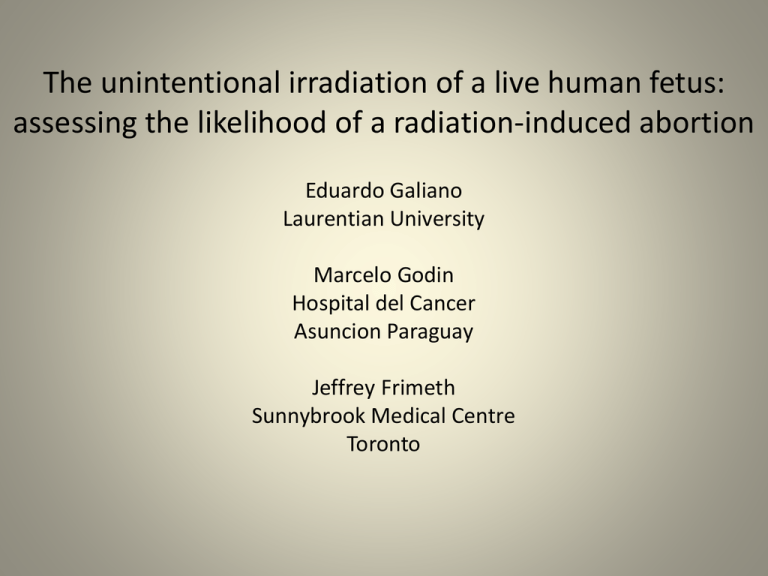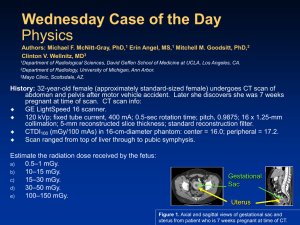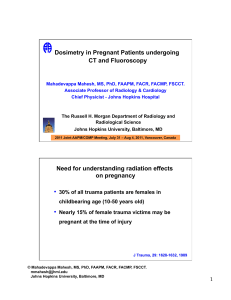SEMINAR
advertisement

The unintentional irradiation of a live human fetus: assessing the likelihood of a radiation-induced abortion Eduardo Galiano Laurentian University Marcelo Godin Hospital del Cancer Asuncion Paraguay Jeffrey Frimeth Sunnybrook Medical Centre Toronto PURPOSE: To calculate dose accidentally absorbed by a live fetus during diagnostic CT procedure (to mother), and then assess likelihood that premature termination of pregnancy was radiation-induced. In most jurisdictions, regulations require that any dose misadministration be investigated and documented, to address administrative and medico-legal issues. More so in cases involving individuals from general population (non-patients) unintentionally exposed. These episodes however present investigators with possibility of extracting radiobiological data otherwise impossible to obtain. The dose to a fetus cannot be measured directly, however estimation methods of reasonable accuracy have been developed based on physical phantom measurements and/or numerical simulations. Hospital del Cancer, Paraguay METHODS: At HCP a 34 y.o. patient underwent CT scan as part of clinical work up for a FIGO stage IIB cervical cancer (means beyond the cervix i.e. uterus). 5 year survival is 65%, frequency at diagnosis is 28%. Patient found to be approx 12 weeks pregnant. Two weeks later, fetus became non-viable. As precaution, radiotherapy initially excluded for this patient and fetus removed in Wertheim-Meigs procedure. Patient then received 50 Gy of external beam therapy, and 15 Gy of conventional LDR brachytherapy. Patient suffered episodes of renal insufficiency, and psychoses, and expired approximately 6 mo. after initial consultation, from complications of parametrial metastases (connective and fatty tissues surrounding uterus) . To address administrative and medico-legal implications, hospital administration referred case to the Physics Department for further dosimetric evaluation. Intent of referral was to determine what role - if any - fetal dose played in the premature termination of the pregnancy. The fetal dose was determined using Wagner’s CTDI Phantom Dose Reference Model method, based on calculating the dose in single slice of the phantom within the primary beam, and then accounting for the scatter component from the remaining slices. This is somewhat analogous to the concept of FSF in radiotherapy. L. Wagner, et.al., Medical Physics Publishing, Madison, WI (1997). Anatomical structures clearly visible on the fetus include the calvarium, distal left upper extremity, epyphyseal growth plates of the lower extremities, and both feet. CT scan clearly showing a 90º rotation of the fetus around the caudo-cephalic axis. Vertebral bodies, upper extremities, and pelvic structures, are obvious. Multiple Scan Average Dose (Clinical Concept) • Determining the dose from multiple slices (scans). • Dose profiles from adjacent slices overlap and create a distribution of peaks and troughs. • An average of this distribution is the MSAD. Computed Tomography Dose Index -CTDI (Physical Concept) • Average dose (along z-axis) from a series of acquisitions 1 CTDI D( z )dz NT • N = number of slices = 32 • T = width of one tomographic section = 6mm • D(z) = dose profile along the z-axis (obtained experimentally under clinical-like conditions) • CTDI’s are not doses to patients but rather doses to phantoms. • 16 cm or 32 cm diameter phantoms are commonly used to simulate doses to pediatric or adult patients. CTDIc (kVp) vs. Phantom Diameter RESULTS: Our estimated absorbed dose to the fetus was 19.3 mGy. Comfortably below the consensus levels for negligible risk (50–150 mGy). C.H. McCollough, B.A. Schueler, T.D. Atwell, et al., “Radiation exposure and pregnancy: when should we be concerned?” RadioGraphics 27(4):909–917 (2007). Additionally, this fetus was approximately 12 weeks old at time of exposure thus well past most radiosensitive phase of organogenesis. Within this phase, it is the initial 10 days of pregnancy which are of most concern regarding a possible radiation-induced abortion. E. Hall, “Radiobiology for the Radiologist: 5th Ed.” Lippincott Williams and Wilkins, Philadelphia, PA ( 2000). CONCLUSION: Based on these considerations, our best estimate is that the probability of a radiation-induced abortion from this CT scan is extremely small and can be safely ignored. Thus, the premature termination of this pregnancy can be reasonably attributed to other causes. 3 minute CT exam and taken to the operating room. Free blood Kidney ripped off aorta (no contrast in it) Splenic laceration Part 6. Medical Exposure 13 Example of justified use of CT in a pregnant female who was in a motor vehicle accident ribs Fetal skull Blood outside uterus Fetal dose 20 mGy Part 6. Medical Exposure 14 Additional References 1) J.P. Felmlee, J.E. Gray, M.L. Leetzow, and J.C. Price, Am J Roentgenol 154(1):185–190 (1990). 2) L.M. Hurwitz, T. Yoshizumi, R.E. Reiman, et al., Am J Roentgenol 186(3):871–876 (2006). 3)ImPACT CTDosimetry. Imaging performance assessment of CT scanners. http://www.ImPACTscan.org. 4) D.G. Jones, P.C. Shrimpton, NRPB R-250. Chilton, England: National Radiological Protection Board (1991). 5) W.S. Snyder, H.L. Fisher, M.R. Ford, et al., J Nucl Med (supp 3):7–52 (1969). 6) Siemens Somatom Spirit CT Application Guide (2007). 7) 10)AAPM Report No. 96: AAPM TG 23 of the Diagnostic Imaging Council CT Committee, January 2008. 8)Nickoloff, Dutta, Lu, Medical Physics: 30, March 2003.








